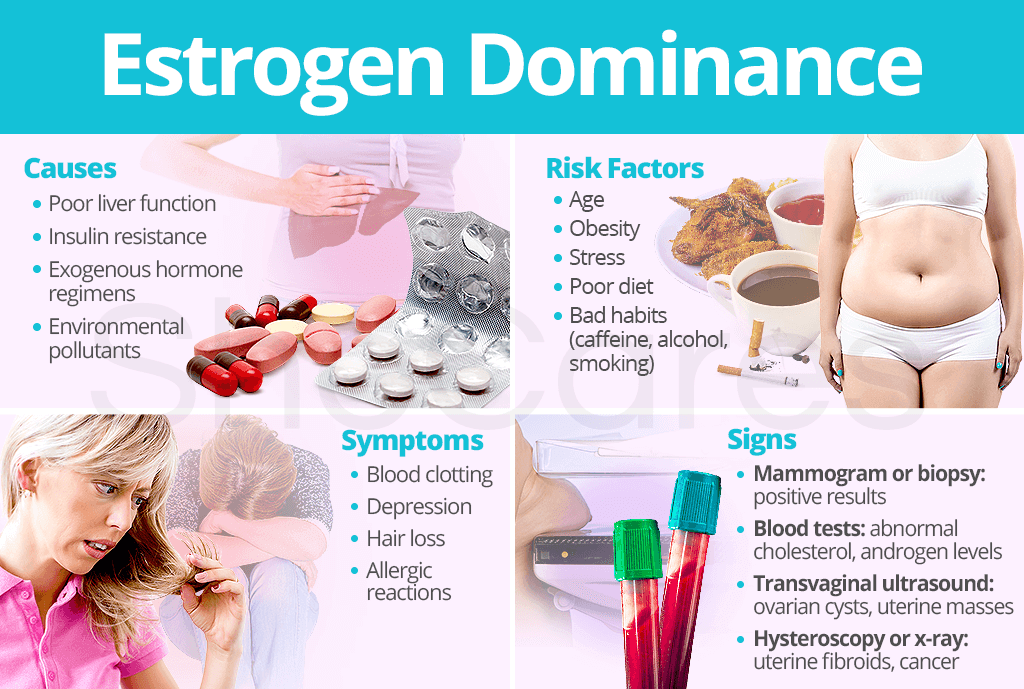When a surplus of estrogen exists within the body, the condition that results is known as estrogen dominance. Just as with estrogen deficiency, estrogen dominance also has its unique list of causes, risk factors, signs and symptoms.
Understanding this condition is a pivotal first step towards treatment and better health.
What Is Estrogen Dominance?
Estrogen dominance is not solely defined as high estrogen levels, but a state when a woman has normal or excessive estrogen with little or no progesterone to balance out its effects in the body.
For the most part, progesterone works in conjunction with estrogen by helping the body to break it down, absorb it, and remove it. Since both hormones work in unison, the body needs both to function correctly.
Causes of Estrogen Dominance
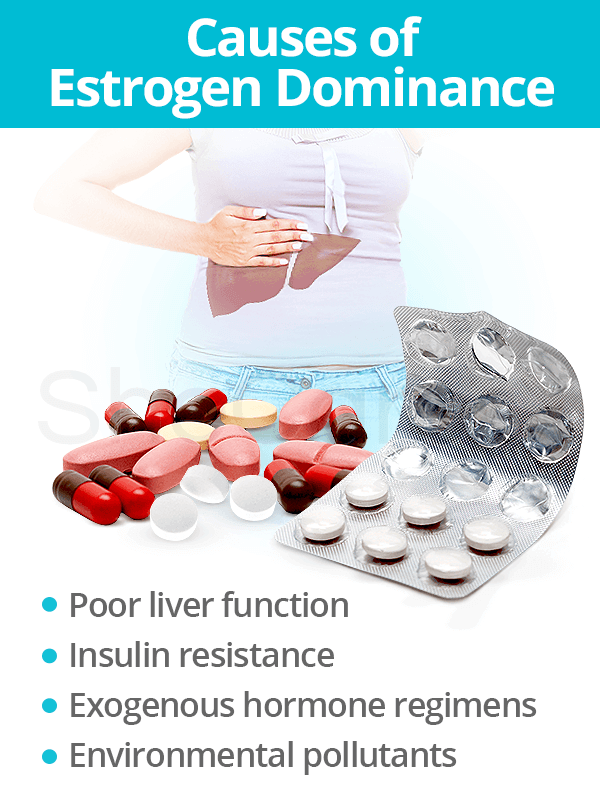
Because the endocrine system is very sensitive and might be affected by a range of factors, identifying the cause of estrogen dominance from symptoms exhibited is key in moving forward toward optimal health.
Primary causes of estrogen dominance, aside from the transition into menopause, include poor liver function, insulin resistance, use of exogenous hormones, and exposure to environmental pollutants.
Poor liver function
Estrogens are metabolized and excreted from the body by metabolic conversion to inactive metabolites in the liver. Then, they are eliminated in urine or feces. If this process is not working properly, it can generate high estrogen levels or reabsorption of estrogen back into the body.
Insulin resistance
Insulin resistance is a condition in which the body's cells become resistant to insulin, a hormone that regulates the amount of glucose in the blood. The condition is a risk factor for diabetes and heart disease.
Furthermore, insulin resistance causes extra glucose to be converted to fat, and that fat produces extra estrogen, causing estrogen dominance.
Exogenous hormones
Use of birth control pills and prescription medications - including those used during HRT - may elicit estrogen dominance. These are not human-made hormones; therefore, the by-products of these foreign drugs cannot be properly broken down and removed from the body.
Premarin, specifically, has been linked to deregulating reproductive hormones and so have other steroid medications, digitalis, ampicillin, gonadotropins, tetracycline, phenothiazines, and cimetidine.
Environmental pollutants
Non-biodegradable, endocrine-disrupting heavy metals - lead, arsenic, and mercury - and hormonally active xenoestrogens alter normal hormone functioning and increase the subsequent amount of estrogen in the body.
They are found in pesticides; fungicides; plastics (BPA); commercial meats; car exhaust; petroleum-based household products; beauty products (such as shampoos, soaps, perfumes, and cosmetics); and more. Reducing use of and exposure to these triggers can help correct estrogen dominance.
Risk Factors of Estrogen Dominance
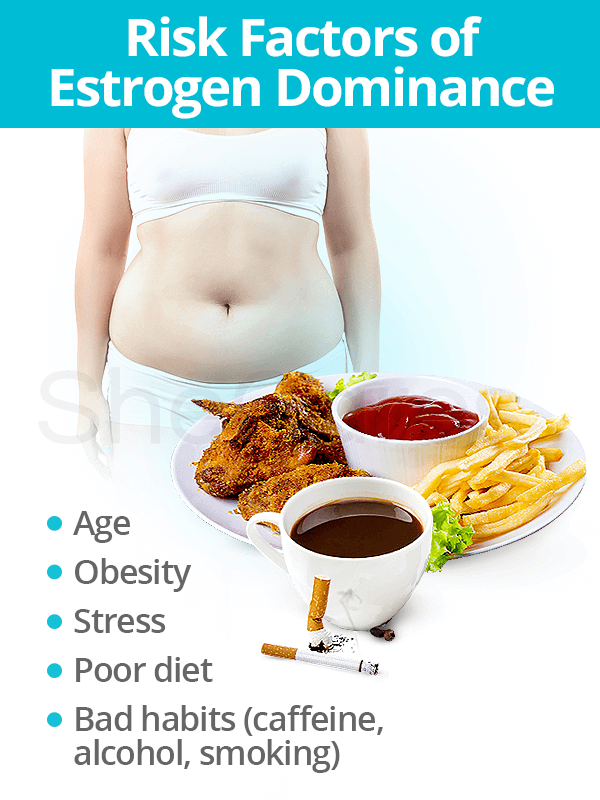
Additionally, risk factors are characteristics that serve as potential reasons for women to have estrogen dominance. There are a variety of risk factors that make women more susceptible to this hormonal imbalance.
- Health risk factors. Women who fall under the following categories may have a heightened risk of having estrogen dominance.
- Age. When egg quality declines, so does the integrity of the corpus luteum, which is what produces the most progesterone. With no progesterone, estrogen goes unopposed. Moreover, anovulatory cycles further enhance estrogen dominance.
- Obesity. Fat cells produce a type of estrogen called estrone. Many overweight women struggle with hormonal imbalances by suffering from excess estrogen, excess insulin, and an underactive thyroid.
- Behavioral risk factors. More research is emerging that links estrogen dominance to behavior factors, including:
- Stress. High levels of stress leads to an overproduction of cortisol in the body, which suppresses progesterone production and causes an estrogen dominant state.
- Cigarette smoking. Research studies have proven that since smokers have shorter follicular phases of their menstrual cycles, there is an improper development of the follicle and subsequent corpus luteum. This leads to a progesterone deficiency.
- Caffeine. Excessive caffeine intake has the potential to increase estrogen production and secretion. Interestingly, the rise in estrogen levels from caffeine consumption depends upon a woman's ethnicity.
- Poor diet. Having a diet low in fiber and high in trans-fatty acids; commercial beef and poultry (that have been fed estrogen-like hormones); and sugar/ processed foods can also cause estrogen dominance.
- Alcohol. Research has shown that circulating estrogen levels are higher in women who consume above normal amounts of alcohol. Consumption of two daily alcoholic drinks can raise a woman's blood and urine estrogen levels by 30 percent.
Estrogen Dominance Symptoms
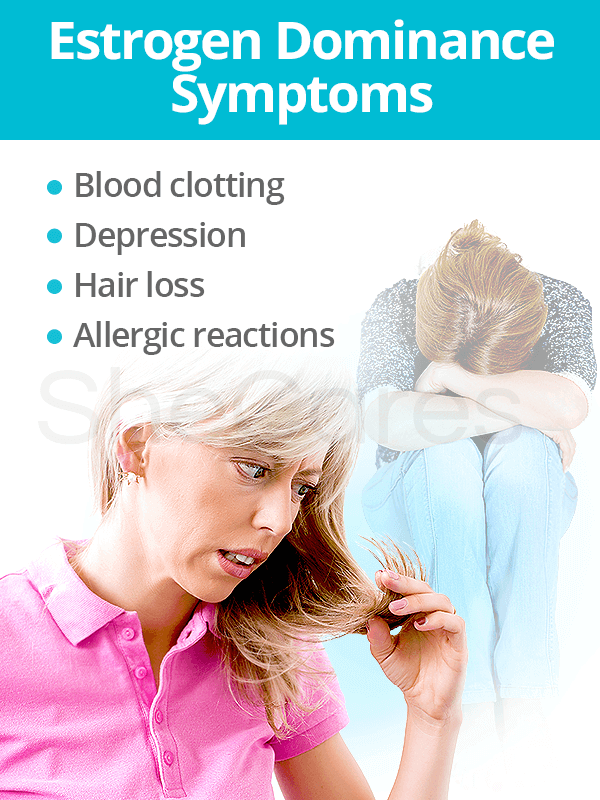
Women with estrogen dominance can experience an assortment of physical and psychological symptoms that are more intense than “typical” symptoms, such as fatigue, irritability, hot flashes, irregular periods, cravings, etc.
Although estrogen dominance symptoms are similar to those of high estrogen levels, they are normally ongoing and can develop into further complications.
A few of the more pressing symptoms related to estrogen dominance include:
- Allergic reactions
- Blood clotting
- Increased cholesterol levels
- Depression
- Hair Loss
- Migraines
- Water retention
- And more
Complications of Estrogen Dominance
Symptoms that collect over time may develop into more serious complications. Estrogen dominance difficulties and their symptoms include, but are not limited to:
- Breast cancer
- Swelling of all or part of a breast
- Breast or nipple pain
- Nipple retraction (turning inward)
- Nipple discharge (other than breast milk)
- Ovarian cancer
- Pain during sexual intercourse
- Pelvic/ abdominal pain or bloating
- Difficulty eating or feeling full quickly
- Frequent and urgent urination
- Polycystic ovarian syndrome (PCOS)
- Infertility
- Acne or oily skin
- Excessive hair growth on face and body (hirsutism)
- Thinning hair on scalp and male-patterned baldness
- Uterine fibroids
- Abnormal bleeding between menstrual cycles
- Pelvic pain (causes as the tumor presses on pelvic organs)
- Frequent urination
- Lower back pain
- Pain during sexual intercourse
The same complications can also arise with a similar hormonal imbalance known as progesterone deficiency.
Signs of Estrogen Dominance
As opposed to more noticeable estrogen dominance symptoms, medical signs are measurable criteria that are usually assessed by a physician.
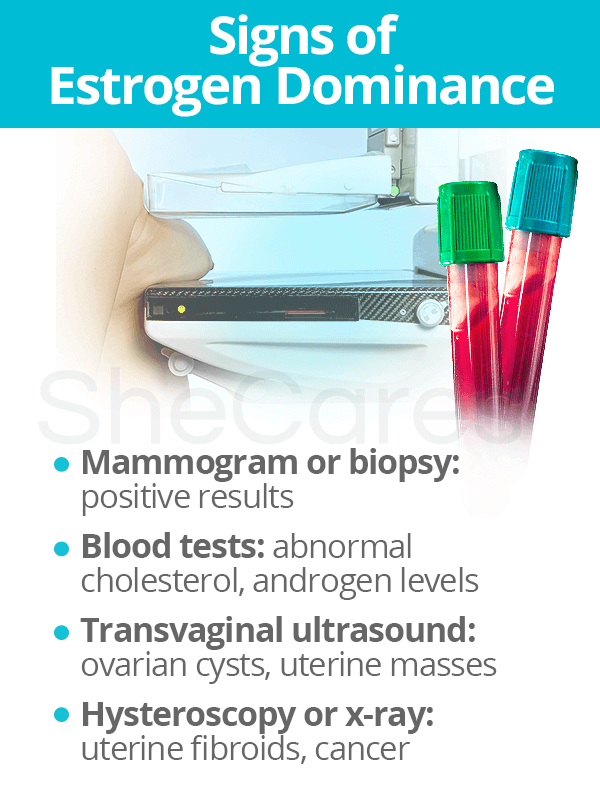
The following medical tests produce results that will be taken into account when diagnosing symptoms related to estrogen dominance.
- Positive mammogram or endometrial/ breast biopsy results
- Blood tests showing abnormal cholesterol, androgen, or blood glucose levels
- Transvaginal ultrasound showing various ovarian cysts or uterine masses
- Hysteroscopy or x-ray showing presence of uterine fibroids or cancer
- Estrogen tests (blood, saliva, or urine) proving the elevation of estrogen for extended period of time
Methods to manage and treat estrogen levels before they worsen are just a click away. Continue reading to find out about lowering estrogen levels.
Sources
- American Cancer Society. (2016). Understanding Your Mammogram Report | Breast Biopsy | Breast Cancer Signs and Symptoms. Retrieved August 7, 2017, from https://www.cancer.org/cancer/breast-cancer/screening-tests-and-early-detection/mammograms/understanding-your-mammogram-report.html | https://www.cancer.org/cancer/breast-cancer/screening-tests-and-early-detection/breast-biopsy.html | https://www.cancer.org/cancer/breast-cancer/about/breast-cancer-signs-and-symptoms.html
- Diamanti-Kandarakis, E. et al. (2009). Endocrine-Disrupting Chemicals: An Endocrine Society Scientific Statement. Endocrine Reviews, 30(4), 293-342. doi: 10.1210/er.2009-0002
- Hormone Health Network. (2010). Polycystic Ovary Syndrome (PCOS). Retrieved August 7, 2017, from http://www.hormone.org/diseases-and-conditions/womens-health/polycystic-ovary-syndrome
- Khattar, D. et al. (2015). Correlating Estrogen Levels and Cognitive Functions in Regularly Menstruating Females of Reproductive Age Group and Post Menopausal Women of North India. Journal of Family and Reproductive Health, 9(2), 83-88. Retrieved August 7, 2017, from https://www.ncbi.nlm.nih.gov/pmc/articles/PMC4500819/
- National Institutes of Health. (2012). NIH Study shows caffeine consumption linked to estrogen changes. Retrieved August 4, 2017, from https://www.nih.gov/news-events/news-releases/nih-study-shows-caffeine-consumption-linked-estrogen-changes
- The North American Menopause Society. (2010). Changes in Hormone Levels. Retrieved August 2, 2017, from https://www.menopause.org/for-women/sexual-health-menopause-online/changes-at-midlife/changes-in-hormone-levels
- Ovarian Cancer Research Fund Alliance. (n.d.). Symptoms and Detection. Retrieved August 7, 2017, from https://ocrfa.org/patients/about-ovarian-cancer/symptoms-and-detection/
- Prevention Health Books. (1996). Prevention's Healing with Vitamins. New York: Holtzbrink Publishers. Available from Google Books.
- UCLA Health. (n.d.). Fibroids. Retrieved August 7, 2017, from http://obgyn.ucla.edu/fibroids
- University of Maryland Medical Center. (2012). Menopause. Retrieved August 2, 2017, from http://www.umm.edu/health/medical/reports/articles/menopause
- Warren, M.P. (2011). Endocrine Manifestations of Eating Disorders. Journal of Clinical Endocrinology & Metabolism, 96(2), 333-343. doi: https://doi.org/10.1210/jc.2009-2304
- Wilcox, G. (2005). Insulin and Insulin Resistance. The Clinical Biochemist Reviews, 26(2), 19-39. Retrieved August 4, 2017, from https://www.ncbi.nlm.nih.gov/pmc/articles/PMC1204764/
- Windham, G.C. et al. (2005). Cigarette Smoking and Effects on Hormone Function in Premenopausal Women. Environmental Health Perspectives, 113(10), 1285-1290. doi: 10.1289/ehp.7899
- Wright, Y.L. (2012). Bioidentical Hormones Made Easy! USA: Lulu.com. Available from Google Books.
